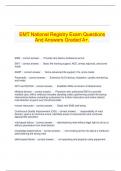Exam (elaborations)
EMT National Registry Exam Questions And Answers Graded A+.
- Course
- Institution
EMT National Registry Exam Questions And Answers Graded A+. EMR - correct answer. Provide care before ambulance arrive EMT - correct answer. Basic life training support, AED, airway adjuncts, and some meds AEMT - correct answer. Some advanced life support, IVs, so...
[Show more]



